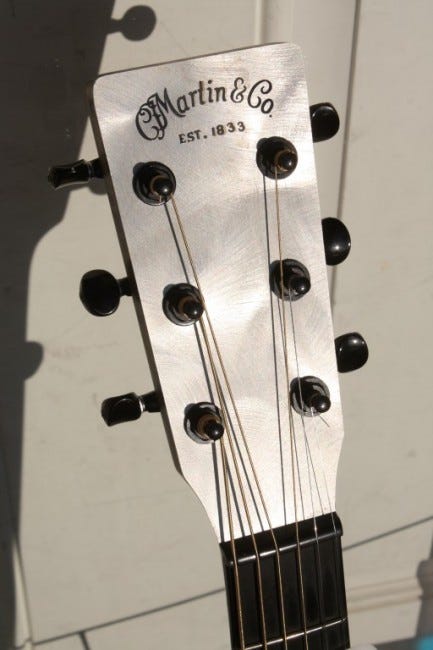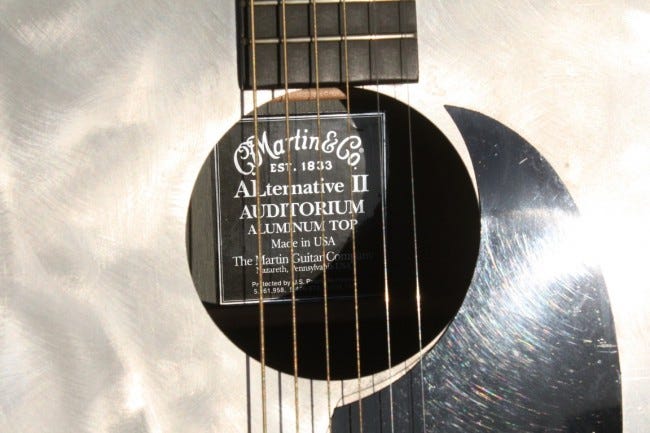Adventures In Cheapo Guitars; Farewell To The SL

Long-time readers of this blog know I'm deeply in love with my RainSong JM-1000. I'm also interested in, and excited by, the potential for guitars that aren't made of wood, both acoustic and electric. (I also have a Fano Psonicsphear.) This weekend, I had a chance to pick up another different strummer, so to speak, at a bargain price.
This is a Martin Alternative II Auditorium guitar. My bass player, Patrick, had previously owned a Martin Alternative X, which is a cousin of sorts, being constructed in the same fashion. I can't say for certain which came first; from the sources I can find on the Internet it looks like the Alternative X was released in 2001 as a 00-size guitar and the Alternative II was a special edition 000-size released in 2002. The original receipt for mine shows a purchase date of 2/14/2004, from Quigley Music in Kansas City, and a price of $780 discounted from retail of $1199. The 2004 Martin price list contains the Alternative X but not the II. I think I'm going to have to stump up for the Martin Technical Reference book to get an authoritative answer.

The construction of the guitar is kind of a quick tour of all the ideas that Martin has for doing guitars in the future. The top is the Stratabond laminate neck that's appearing on most of their cheaper models nowadays. It hasn't always been problem-free and there's a disturbing amount of plastic and (completely synthetic) glue involved in its construction but it's stable across a wide variety of temperature and humidity. The back and sides are the HPL wood-chip laminate that also features in the entry-level Martins nowadays. The fretboard is Richlite, which is recycled paper soaked in plastic then compressed into a hard material. So far we're basically talking recycled garbage, literally; the HPL is made of recycled wood waste, the Richlite is made of recycled paper waste, and the Stratabond isn't recycled but it's made from wood that isn't highly valued elsewhere. (You can read more about these materials here.)

The top is something else entirely: a thin sheet of aluminum glued in just like the spruce, mahogany, or koa soundboards found in other Martins. It's rough-finished on top, and that's part of why I paid $400 out the door for this guitar; there's some corrosion in the top, some dark spots that will require polishing out. I don't mind doing that.
So you can see how it looks. How does it sound? The answer is: pretty good, considering. I'll record something with it in the near future, perhaps back to back with my Martin D-41 and/or 000-15 for perspective. I'm not terribly good at using the conventional guitar-review terminology for acoustics, but I can say that, in contrast to what you'd expect, the Alternative II is most comfortable being played with relatively low force. Strumming hard leads to a really "compressed" sound. In that respect, it ain't no D-41. You'd think that aluminum would be more expressive and powerful under harsh use but it turns out that it's very sensitive.
The neck is smooth and playable; the tuners are in solid shape. I haven't tried the Fishman Prefix electronics yet but I don't believe in using the "electric" part of an acoustic guitar unless there's no other option available. So far, I have about two hours of play time on it and it's been great. You can't do better for $400. If you want to spend twice as much and get a better-condition one, here you go.
The Martin was one of the two reasons I was in Cincinnati Saturday morning; the other was to sell my 560SL. I've enjoyed driving it more than I can easily express, but the hassle in having no fewer than four two-door cars in the driveway was starting to grate on me and I don't feel as good about driving my son around in the thing as I used to. On the positive side of things, that kind of frees up room for a future vehicle, maybe in conjunction with a sale of my Boxster. More information on that as it's available and I get my head together.

